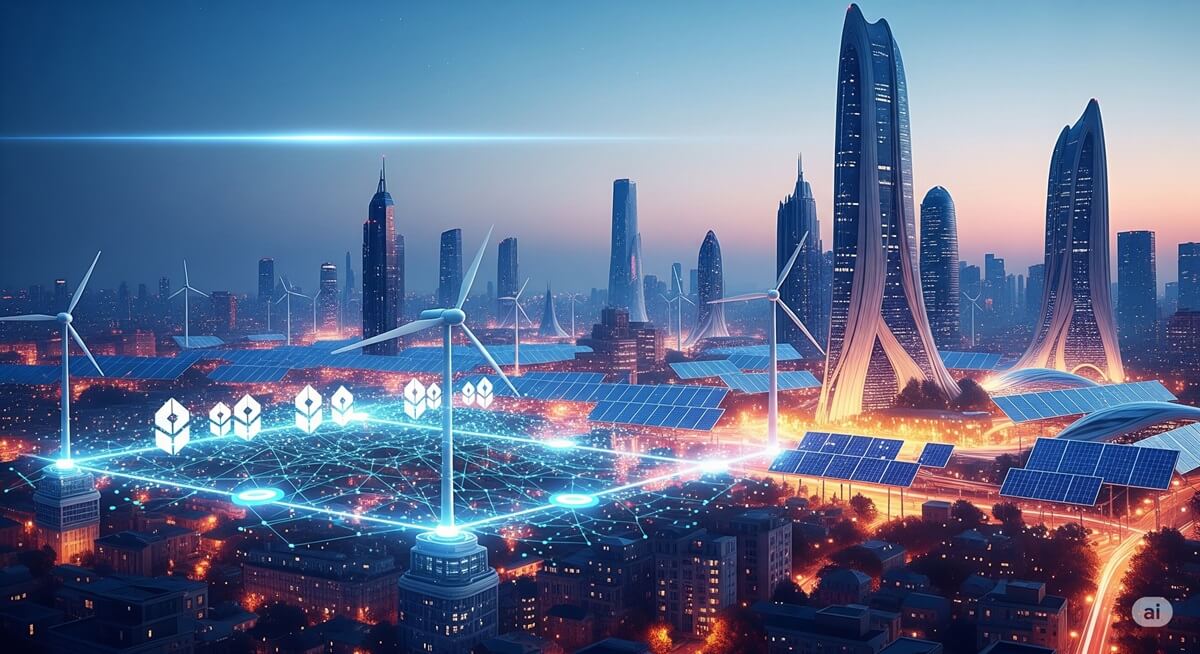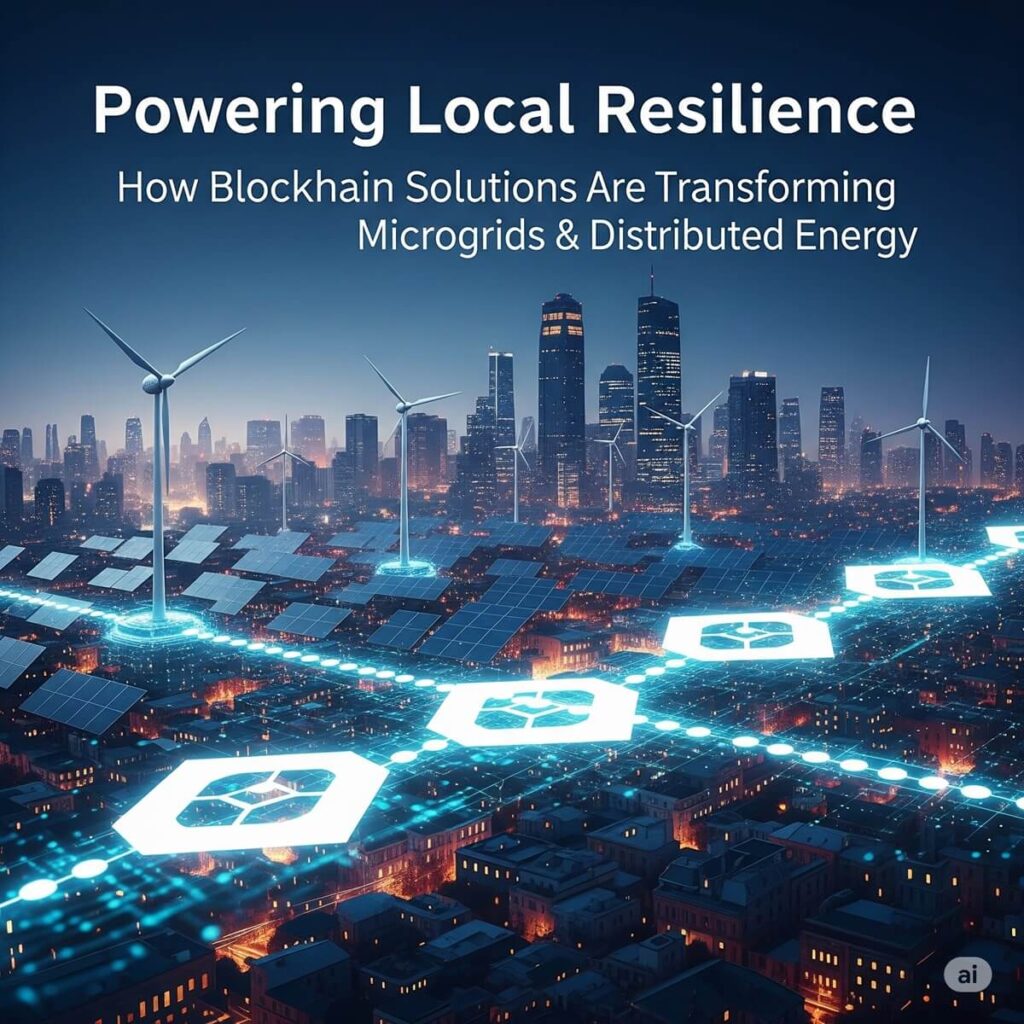Powering Local Resilience: How Blockchain Solutions Are Transforming Microgrids & Distributed Energy

The modern energy landscape is a paradox of progress and vulnerability. While centralized grids have powered our societies for decades, they are increasingly susceptible to disruption. From devastating outages caused by extreme weather events and natural disasters to the insidious threat of cyberattacks and the instability of global energy markets, the need for robust, local power solutions has never been more urgent. This growing fragility has thrust microgrids and Distributed Energy Resources (DERs) into the spotlight as crucial components for a resilient energy future.
Microgrids are localized energy grids that can operate autonomously, integrating various energy sources and loads within a defined area. DERs, such such as rooftop solar, battery storage systems, and even electric vehicles, represent smaller, modular energy generation units located at or near the point of consumption. Individually, they offer promise. Collectively, and powered by innovative technology, they represent a profound shift.
Enter blockchain. This revolutionary technology, best known for cryptocurrency, is now poised to unlock the full potential of these decentralized energy systems. This article will explore why blockchain solutions for microgrids and distributed energy are not just about incremental improvements, but about fundamentally reshaping how we generate, consume, and trade power. We’ll delve into the challenges of traditional energy systems, how blockchain uniquely addresses them, showcase real-world examples, highlight the transformative benefits for all stakeholders, address existing hurdles, and look to the exciting future of this convergence, ushering in unprecedented local energy independence and resilience.
- 1. The Promise of Local Power: Microgrids & Distributed Energy Resources
- 2. The Grid’s Growing Pains: Why Traditional Systems Fall Short
- 3. Blockchain as the Backbone: Enabling True Energy Democracy & Resilience
- 4. Real-World Sparks: Blockchain Microgrid Case Studies & Innovations
- 5. Benefits Beyond the Meter: Who Wins with Blockchain-Powered Local Energy
- 6. Bridging the Gap: Challenges to Widespread Blockchain Adoption in Microgrids
- 7. The Future is Decentralized: AI, IoT, and Blockchain’s Energy Frontier
- Conclusion: A Resilient, Community-Powered Energy Future
- Frequently Asked Questions (FAQs) About Blockchain in Microgrids
- Q2: How does blockchain enable peer-to-peer (P2P) energy trading in microgrids?
- Q3: What are the main benefits of using blockchain for distributed energy resources (DERs)?
- Q4: Can you give an example of a real-world blockchain microgrid project?
- Q5: What are the biggest challenges to adopting blockchain in microgrids today?
1. The Promise of Local Power: Microgrids & Distributed Energy Resources
The energy system of tomorrow looks vastly different from the one that powered the 20th century. At its core are microgrids and DERs:
- Microgrids Defined: Imagine a local power grid for a university campus, a hospital, or an entire neighborhood. This is a microgrid – capable of generating its own power, managing its demand, and crucially, “islanding” itself from the main grid during an outage.
- Enhanced Energy Resilience: By disconnecting from a troubled main grid, a microgrid can maintain power, ensuring essential services remain operational during blackouts caused by storms, natural disasters, or grid failures.
- Improved Energy Efficiency: Generating power closer to where it’s consumed reduces transmission losses, leading to greater efficiency and potentially lower costs.
- Integration of Local Renewables: Microgrids are ideal for incorporating intermittent renewable sources like solar and wind, balancing their output with local demand and storage.
- Distributed Energy Resources (DERs): These are the building blocks of microgrids and the agents of energy decentralization. They include:
- Residential and commercial rooftop solar photovoltaic (PV) systems.
- Battery energy storage systems (BESS) at homes, businesses, or utility scale.
- Small-scale wind turbines.
- Electric Vehicles (EVs) acting as mobile storage units (Vehicle-to-Grid, V2G).
- Smart appliances and demand-response technologies. The proliferation of DERs marks a fundamental shift from a centralized, unidirectional power flow to a dynamic, multi-directional energy exchange. The National Renewable Energy Laboratory (NREL) highlights their growing role in a resilient and sustainable energy future.
2. The Grid’s Growing Pains: Why Traditional Systems Fall Short
While the potential of microgrids and DERs is immense, integrating them into existing, often rigid, energy frameworks presents significant challenges:
- Centralized Control Limitations: Traditional grid architecture is designed for large power plants pushing energy out to consumers. It struggles to efficiently manage, optimize, and coordinate the vast number of smaller, fluctuating DERs spread across a region.
- Inefficient Energy Trading: In conventional systems, if a homeowner with solar panels generates excess power, they typically sell it back to the utility at a fixed, often low, rate. There’s no transparent, real-time mechanism for them to sell that power directly to a neighbor who needs it.
- Complex Billing & Settlement: Managing energy transactions between multiple prosumers and consumers within a local microgrid often involves cumbersome, manual processes for billing and settlement, leading to inefficiencies and delays.
- Trust & Data Integrity: Centralized energy databases can be single points of failure, vulnerable to cyberattacks or internal manipulation, potentially compromising the integrity of energy data and transactions.
- Limited Market Access for Small Producers: Individual homeowners or small businesses generating renewable energy often face high barriers to truly participate in wholesale energy markets or even local energy markets.
- Vulnerability to Disruption: The inherent design of centralized grids means that a fault or attack at a key node can lead to widespread blackouts, impacting large populations.
3. Blockchain as the Backbone: Enabling True Energy Democracy & Resilience
Blockchain technology, with its decentralized, transparent, and immutable ledger capabilities, offers powerful solutions to these challenges, making it the ideal backbone for the future of blockchain microgrids and distributed energy resources (DERs) blockchain:
- Peer-to-Peer (P2P) Energy Trading: This is arguably blockchain’s most transformative application in energy. Smart contracts, self-executing agreements stored on the blockchain, enable direct, automated transactions between energy prosumers and consumers within a microgrid.
- Mechanism: When a homeowner’s solar panels produce surplus energy, a smart contract can automatically sell that energy to a neighbor in real-time, based on pre-agreed rules and prices.
- Benefits: This creates dynamic local energy markets, leading to increased revenue for prosumers, potentially lower costs for consumers, and greater energy independence for the community.
- Enhanced Resilience & Security:
- Decentralized Control: By eliminating a single point of central control, blockchain-enabled microgrids are inherently more resilient to cyberattacks or physical disruptions, as data and operations are distributed across the network.
- Immutable Records: The tamper-proof nature of blockchain ensures the integrity of all energy generation, consumption, and transaction data, building unprecedented trust and transparency.
- Automated Grid Balancing: Smart contracts can monitor real-time grid conditions and automatically trigger demand response mechanisms or activate distributed energy storage systems to balance supply and demand within the microgrid, preventing overloads or shortages.
- Efficiency & Automation: Blockchain streamlines processes by automating billing and settlement. Payments are executed seamlessly and instantly based on predefined rules, drastically reducing administrative overhead and disputes.
- Democratization & Market Access: Blockchain empowers individual prosumers and small community energy initiatives. It provides them with direct control over their energy assets and facilitates participation in local energy economies, fostering genuine community energy solutions and promoting energy democracy.
- Verification & Transparency: The immutable ledger provides verifiable records for Renewable Energy Certificates (RECs) or carbon credits, ensuring the authenticity of green energy claims and preventing double-counting, crucial for carbon accounting.
4. Real-World Sparks: Blockchain Microgrid Case Studies & Innovations
The promise of blockchain in microgrids is already being realized in innovative pilot projects worldwide, showcasing tangible benefits:
- Brooklyn Microgrid (LO3 Energy, New York, USA): One of the pioneering and most well-known blockchain microgrid projects. LO3 Energy’s platform enables residents and businesses in Brooklyn to buy and sell locally produced solar energy directly to each other, using blockchain-verified transactions and smart meters. This project vividly demonstrates local energy independence and the creation of vibrant local energy markets.
- Power Ledger (Australia & International): A leading global platform that has implemented numerous projects facilitating peer-to-peer energy trading through blockchain. Their solutions enable apartment complexes or entire communities to efficiently trade excess solar power, optimizing local energy use.
- Energy Web Foundation (EWF): EWF has developed an open-source, public blockchain platform specifically designed for the energy sector. Their focus is on decentralizing energy markets and facilitating the seamless integration of DERs for utilities and grid operators across various use cases.
- Grid Singularity (Europe): This company is building a decentralized energy data exchange platform using blockchain. Their goal is to enable secure and transparent data sharing for various energy market participants, from generators to consumers. These examples illustrate how blockchain is moving beyond theoretical discussions to practical, impactful applications that enhance energy resilience and empower local communities.

5. Benefits Beyond the Meter: Who Wins with Blockchain-Powered Local Energy
The widespread adoption of blockchain microgrids delivers multifaceted advantages across the entire energy ecosystem:
- For Communities & Localities:
- Achieve unprecedented energy independence and autonomy from the main grid.
- Experience enhanced resilience during outages caused by severe weather or other disruptions.
- Potentially benefit from lower energy costs through efficient local trading.
- Foster stronger community bonds and collective action on climate and sustainability goals.
- For Prosumers (Individuals & Businesses with DERs):
- Unlock new revenue streams from selling surplus energy directly to neighbors or the local grid.
- Gain greater control and transparency over their own energy consumption and generation.
- Reduce overall electricity bills by optimizing self-consumption and local sales.
- For Utilities & Grid Operators:
- Improve grid stability and management through better integration and orchestration of decentralized DERs.
- Create new opportunities for demand response and peak load reduction, optimizing grid efficiency.
- Access real-time, auditable data for superior grid planning and operational insights.
- Explore new service models, transitioning from traditional power providers to orchestrators of local energy markets.
- For Investors & Developers:
- Discover exciting new investment opportunities in decentralized energy infrastructure and innovative climate tech solutions.
- Benefit from more efficient and transparent project financing through asset tokenization.
6. Bridging the Gap: Challenges to Widespread Blockchain Adoption in Microgrids
Despite the compelling benefits, the path to widespread adoption of blockchain solutions for microgrids is not without its hurdles:
- Scalability & Transaction Volume: For dynamic energy markets, blockchain technologies need to process a very high volume of transactions in real-time. While promising solutions like Layer 2 scaling and sharding are being explored, this remains a key technical challenge.
- Regulatory Hurdles: Most existing energy regulations are designed for centralized, monopolistic grids and are not yet equipped to accommodate decentralized, P2P energy trading or autonomous microgrid operations. Policy frameworks need significant evolution.
- Interoperability: Integrating nascent blockchain solutions with often decades-old, legacy grid infrastructure and existing IT systems is complex and requires significant investment and standardization efforts.
- Energy Consumption Perception: While many modern energy blockchains utilize highly energy-efficient consensus mechanisms (like Proof-of-Stake), the lingering public perception linking blockchain to the high energy consumption of early Proof-of-Work systems (like Bitcoin) can be a misconception barrier.
- Lack of Standardization: The absence of universal standards for blockchain protocols, data formats, and smart contract functionalities in the energy sector hinders broader adoption and seamless integration across different projects.
- Technical Complexity & Talent Gap: The underlying technology is still relatively new and complex, requiring specialized skills for development, deployment, and ongoing management, leading to a shortage of qualified professionals.
7. The Future is Decentralized: AI, IoT, and Blockchain’s Energy Frontier
The future of blockchain microgrids is set to be even more dynamic, driven by the powerful synergy of converging technologies:
- Convergence of Technologies: Blockchain will increasingly work in tandem with:
- Artificial Intelligence (AI): AI can provide predictive analytics for optimizing energy generation and consumption, detect anomalies, and fine-tune P2P trading algorithms for maximum efficiency.
- Internet of Things (IoT): Smart meters, sensors, and connected devices will feed real-time, granular data directly onto the blockchain, enabling automated control, dynamic pricing, and precise responses.
- Growth Projections: The microgrid market is experiencing rapid expansion, and as blockchain technology matures and regulatory clarity improves, its integration is expected to grow exponentially.
- Mainstream Adoption: We anticipate a shift beyond pilot projects to more widespread commercial deployment of blockchain in both new and existing microgrids, transforming local energy ecosystems globally.
- Towards True Energy Democracy: Blockchain’s inherent ability to decentralize control and empower local participation will be a key driver of the broader energy transition towards a more democratic, resilient, and sustainable future, where communities have genuine control over their power.
Conclusion: A Resilient, Community-Powered Energy Future
The vulnerabilities of our current energy infrastructure are clear, but so too is the compelling path forward. Blockchain solutions for microgrids and distributed energy offer a transformative answer, providing unprecedented local resilience, efficiency, and transparency. By leveraging this groundbreaking technology, we are not just optimizing energy flows; we are fundamentally reshaping how we generate, consume, and exchange power, fostering community energy solutions and enabling true energy democracy.
Blockchain acts as the critical backbone, enabling truly decentralized energy markets and empowering individual prosumers and entire communities to take charge of their energy destiny. It’s a vision of a future where power is not just supplied, but shared, managed, and owned by the people.
We encourage utilities, urban planners, policymakers, and local communities to actively explore and invest in blockchain-enabled microgrids. Recognize their immense potential to transform our energy landscape into one that is more robust, equitable, and sustainable. The future of power is increasingly local, and it’s being built on the immutable foundation of trust that blockchain provides.
Frequently Asked Questions (FAQs) About Blockchain in Microgrids
Q1: What is a microgrid, and why is it important for energy resilience?
A: A microgrid is a localized energy grid that can operate independently from the main grid, integrating various local energy sources and loads. It’s crucial for resilience because it can “island” itself during main grid outages, ensuring continued power supply to critical facilities or communities.
Q2: How does blockchain enable peer-to-peer (P2P) energy trading in microgrids?
A: Blockchain uses smart contracts to automate direct energy transactions between local producers (prosumers) and consumers. It provides a transparent and immutable ledger to record energy flows and payments in real-time, eliminating the need for a central intermediary.
Q3: What are the main benefits of using blockchain for distributed energy resources (DERs)?
A: The main benefits include enhanced grid resilience through decentralization, increased efficiency via automated transactions, greater transparency and trust in energy data, empowerment of individual prosumers, and the creation of vibrant local energy markets.
Q4: Can you give an example of a real-world blockchain microgrid project?
A: The Brooklyn Microgrid by LO3 Energy in New York is a prominent example. It enables residents and businesses to buy and sell locally produced solar energy directly to each other using blockchain-verified transactions, demonstrating real-world peer-to-peer energy trading.
Q5: What are the biggest challenges to adopting blockchain in microgrids today?
A: Key challenges include scalability issues to handle high transaction volumes, outdated energy regulations that don’t accommodate decentralized trading, interoperability with existing legacy grid infrastructure, overcoming perceptions of high energy consumption for some blockchains, and the need for greater standardization.



